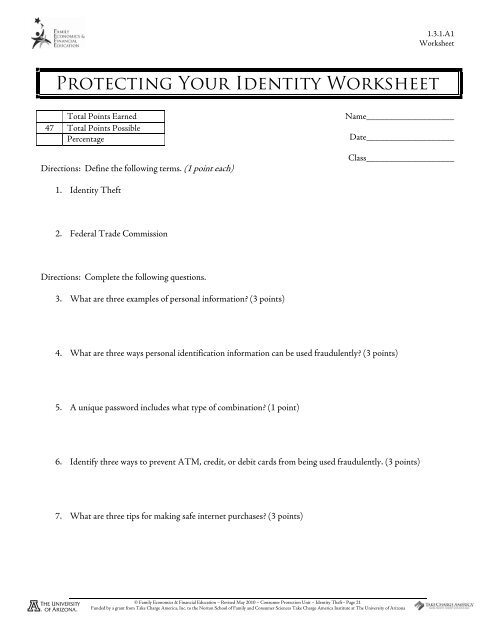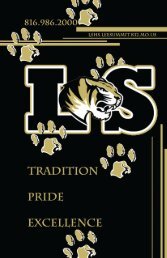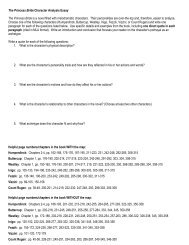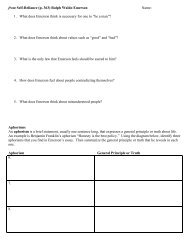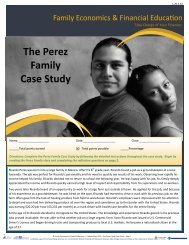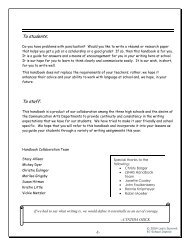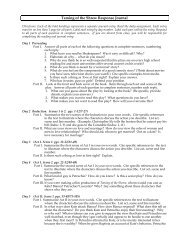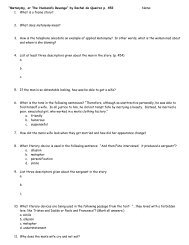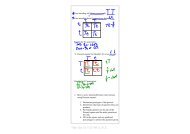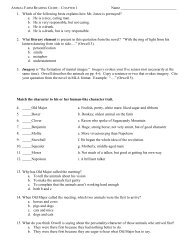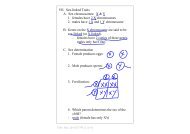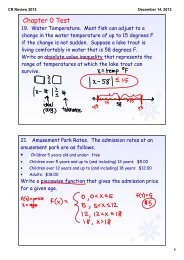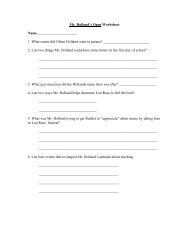Protecting Your Identity Worksheet - LSHS
Protecting Your Identity Worksheet - LSHS
Protecting Your Identity Worksheet - LSHS
Create successful ePaper yourself
Turn your PDF publications into a flip-book with our unique Google optimized e-Paper software.
1.3.1.A1<br />
<strong>Worksheet</strong><br />
<strong>Protecting</strong> <strong>Your</strong> <strong>Identity</strong> <strong>Worksheet</strong><br />
Total Points Earned<br />
47 Total Points Possible<br />
Percentage<br />
Directions: Define the following terms. (1 point each)<br />
Name___________________<br />
Date___________________<br />
Class___________________<br />
1. <strong>Identity</strong> Theft<br />
2. Federal Trade Commission<br />
Directions: Complete the following questions.<br />
3. What are three examples of personal information? (3 points)<br />
4. What are three ways personal identification information can be used fraudulently? (3 points)<br />
5. A unique password includes what type of combination? (1 point)<br />
6. Identify three ways to prevent ATM, credit, or debit cards from being used fraudulently. (3 points)<br />
7. What are three tips for making safe internet purchases? (3 points)<br />
© Family Economics & Financial Education – Revised May 2010 – Consumer Protection Unit – <strong>Identity</strong> Theft– Page 21<br />
Funded by a grant from Take Charge America, Inc. to the Norton School of Family and Consumer Sciences Take Charge America Institute at The University of Arizona
1.3.1.A1<br />
<strong>Worksheet</strong><br />
8. What are three safety tips when using social networks, blogs, and chat rooms on the Internet? (3 points)<br />
9. What are two ways to keep a social security number safe? (2 points)<br />
10. What are three warning signs of identity theft? (3 points)<br />
11. If a person is a victim of identity theft, what are the six steps to follow? (6 points)<br />
12. What dollar amount is a person liable for with unauthorized credit card charges? (1 point)<br />
13. What is the difference between identity theft protection and identity theft insurance? (2 points)<br />
Directions: Match the following methods thieves use to commit identity theft with the correct description. (1 point<br />
each)<br />
A. Diverting Mail<br />
B. Dumpster Diving<br />
C. Hacking<br />
D. Phishing<br />
E. Pretexting<br />
F. Skimming<br />
G. Spyware<br />
H. Stealing<br />
14. ____Thieves steal information that is carelessly discarded into the trash.<br />
15. ____Thieves break into a computer system and steal information.<br />
16. ____Thieves use false pretenses to obtain personal information from depository institutions, telephone<br />
companies, and other sources.<br />
17. ____Thieves access personal information by obtaining personal records from a workplace, tax information,<br />
bank or credit card statements, or pre-approved credit card offers from the mail.<br />
18. ____Thieves attach a device to card processors to obtain credit or debit card information.<br />
© Family Economics & Financial Education – Revised May 2010 – Consumer Protection Unit – <strong>Identity</strong> Theft– Page 22<br />
Funded by a grant from Take Charge America, Inc. to the Norton School of Family and Consumer Sciences Take Charge America Institute at The University of Arizona
1.3.1.A1<br />
<strong>Worksheet</strong><br />
19. ____Software installed on a computer, without the owner’s knowledge or consent, that monitors internet<br />
use, sends pop-up ads, re-directs the computer to other sites, and tracks key strokes.<br />
20. ____Thieves complete a change of address form and have a victim’s bills and statements mailed to a<br />
different location.<br />
21. ____Thieves use a form of electronic communication (usually e-mail) to pretend to be a company or<br />
financial institution in order to get the victim to give up their personal information.<br />
Directions: For the following questions, please indicate if the statement is True or False by writing a T or F on the<br />
line. (1 point each)<br />
22. _____ <strong>Identity</strong> thieves cannot obtain a job under another person’s identity.<br />
23. _____ There is no absolute way to avoid identity theft, but many steps can be taken to minimize risk.<br />
24. _____ Consumers are entitled to one free credit report a year from each of the three credit reporting<br />
agencies.<br />
25. _____ When a consumer pays for identity theft protection, he/she is receiving specialized services that can<br />
only be completed by companies offering identity theft protection.<br />
26. _____ Outgoing mail should be deposited in post office collection boxes rather than unsecured mail boxes.<br />
27. _____ Social Security cards, passports, and birth certificates are safe if they are stored in a wallet or purse.<br />
28. _____ ATM and Debit cards reported within two business days of discovering a theft or loss are not liable<br />
for any fraudulent charges.<br />
© Family Economics & Financial Education – Revised May 2010 – Consumer Protection Unit – <strong>Identity</strong> Theft– Page 23<br />
Funded by a grant from Take Charge America, Inc. to the Norton School of Family and Consumer Sciences Take Charge America Institute at The University of Arizona


